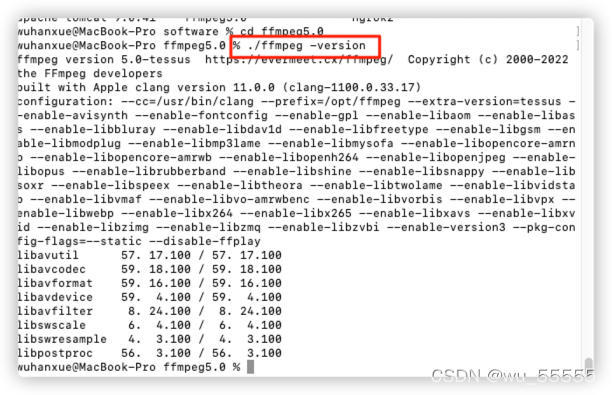0 引言
今天正好计划学习新的课程,因为是下载到本地的视频,为了方便做学习计划,要统计视频时长。不想一个一个的数,就利用ffmpeg做了一个视频时长统计以及自动分配每日学习任务的demo
以此记录方便后续参考
1 环境搭建
1.1 安装ffmpeg
1.1 下载ffmpeg
1.2 双击可执行文件ffmpeg

1.3 查看版本
cd /Library/software/ffmpeg5.0
./ffmpeg -version

2 开发
1、创建springboot项目,修改配置文件
# 应用名称
spring:
application:
name: GetVideoTime
# 应用服务 WEB 访问端口
server:
port: 8888
video:
# 支持的视频格式,多个用,隔开
suffix: .avi,.mp4,.flv,.wmv
# ffmpeg路径,安装步骤参考doc/ffmpeg安装.md
ffmpeg-path: /Library/software/ffmpeg5.0/ffmpeg
2、创建controller
/**
* @author whx
* @date 2022/2/8
*/
@RestController
@RequestMapping("video")
@AllArgsConstructor
public class VideoController {
private final VideoService videoService;
/**
* 获取文件夹下视频总时长
* @param path 文件路径
* @return
*/
@GetMapping("getTime")
public R getTime(String path,Integer studyHour){
return videoService.getVideoTimeFromPath(path,studyHour);
}
}
3、创建返回数据实体类
@Data
@AllArgsConstructor
public class VideoTime {
/**
* 总时长
*/
private String totalTime;
/**
* 时长明细 文件名-时长
*/
private SortedMap<String,String> details;
/**
* 每日任务
*/
private SortedMap<Integer, VideoTime> tasks;
public VideoTime(String totalTime, SortedMap<String, String> details) {
this.totalTime = totalTime;
this.details = details;
}
}
4、创建返回数据包装类
/**
* 返回数据包装类
* @author whx
* @date 2022/2/8
*/
@Data
@AllArgsConstructor
public class R<T> {
private int code;
private String message;
private T data;
public static R success(){
return new R(200,"操作成功",null);
}
public static R fail(String msg){
return new R(500,msg,null);
}
public static <T>R data(T data){
return new R(200,"操作成功",data);
}
}
5、书写主业务代码
/**
* @author whx
* @date 2022/2/8
*/
@Service
@Slf4j
public class VideoServiceImpl implements VideoService {
@Value("${video.suffix}")
private List<String> videoSuffix;
@Value("${video.ffmpeg-path}")
private String ffmpegPath;
@Override
public R getVideoTimeFromPath(String path,Integer studyHour) {
if(studyHour == null){
studyHour = 2;
}
File filePath = new File(path);
if(filePath.exists()){
List<File> files = FileUtil.getVideoFiles(filePath, videoSuffix);
if(files.isEmpty()){
return R.fail(String.format("%s 该路径下未找到视频文件,请检查路径是否有误或者是否在配置文件中配置视频格式",path));
}
TreeMap<String,String> details = new TreeMap<>();
TreeMap<Integer,VideoTime> tasks = new TreeMap<>();
TreeMap<String,String> taskDetails = new TreeMap<>();
AtomicInteger index = new AtomicInteger(1);
AtomicLong videoTime = new AtomicLong();
long studyHourMilSecond = (long) studyHour * 3600 * 1000;
long sum = 0;
for (File file : files) {
try {
long time = readVideoTimeFromCommand(file.getAbsolutePath(),ffmpegPath);
sum += time;
videoTime.addAndGet(time);
String detail = formatTime(time);
if(videoTime.longValue() < studyHourMilSecond){
taskDetails.put(file.getName(),detail);
}else{
tasks.put(index.intValue(),new VideoTime(formatTime(videoTime.longValue()),taskDetails));
videoTime.set(0);
index.incrementAndGet();
taskDetails = new TreeMap<>();
taskDetails.put(file.getName(),detail);
}
log.info(file.getName()+":"+detail);
details.put(file.getName(),detail);
} catch (Exception e) {
log.error("获取视频时长失败:" + e.getMessage());
details.put(file.getName(),"获取失败");
e.printStackTrace();
}
}
String sumStr = formatTime(sum);
log.info("总时长:" + sumStr);
return R.data(new VideoTime(sumStr,details,tasks));
}
return R.fail("%s 该路径不存在,请检查路径是否有误");
}
}
6、获取视频文件方法
public class FileUtil {
private static final File[] EMPTY_FILE_ARR = new File[0];
/**
* 获取文件夹下所有视频文件
*
* @param filePath
* @param videoSuffix
* @return
*/
public static List<File> getVideoFiles(File filePath, List<String> videoSuffix) {
if (filePath == null) {
return new ArrayList<>();
}
List<File> allFile = new ArrayList<>();
allFile.addAll(Arrays.asList(Optional.ofNullable(filePath.listFiles(file -> {
if (!file.isDirectory()) {
for (String suffix : videoSuffix) {
if (file.getPath().endsWith(suffix)) {
return true;
}
}
} else {
allFile.addAll(getVideoFiles(file, videoSuffix));
}
return false;
})).orElse(EMPTY_FILE_ARR)));
return allFile;
}
}
7、获取单个视频时长方法
public static long readVideoTimeFromCommand(String filePath, String ffmpegPath) throws IOException {
ProcessBuilder builder = new ProcessBuilder();
List<String> commands = new ArrayList<>();
commands.add(ffmpegPath);
commands.add("-i");
commands.add(filePath);
builder.command(commands);
builder.redirectErrorStream(true);
Process p = builder.start();
// 获取执行输出信息
BufferedReader br = new BufferedReader(new InputStreamReader(p.getInputStream(), StandardCharsets.UTF_8));
StringBuilder outInfo = new StringBuilder();
String line = "";
while ((line = br.readLine()) != null) {
outInfo.append(line);
}
br.close();
// 通过正则获取时长信息
String regexDuration = "Duration: (.*?), start: (.*?), bitrate: (\\d*) kb\\/s";
Pattern pattern = Pattern.compile(regexDuration);
Matcher matcher = pattern.matcher(outInfo.toString());
if (matcher.find()) {
return getTime(matcher.group(1));
}
return 0;
}
/**
* 获取时间毫秒
* @param time 格式:"00:00:10.68"
* @return
*/
private static long getTime(String time) {
int min = 0;
String[] strs = time.split(":");
if (strs[0].compareTo(ZERO) > 0) {
// 秒
min += Long.parseLong(strs[0]) * 60 * 60 * 1000;
}
if (strs[1].compareTo(ZERO) > 0) {
min += Long.parseLong(strs[1]) * 60 * 1000;
}
if (strs[2].compareTo(ZERO) > 0) {
min += Math.round(Double.parseDouble(strs[2]) * 1000);
}
return min;
}
8、运行测试
这样设定每天2小时的课程时间,要学习哪些视频内容就很清晰了。虽然可能写这些代码的时间比手动统计的时间更长,但是方便以后,也顺便学习了ffmpeg。
当然ffmpeg的作用远不止获取时长,还可以进行视频格式的转换、视频解析等功能

3 其他方式
获取视频时长的方法,除了ffmpeg外还有jave,isoparser等jar包也可以实现,jave本身也是基于ffmpeg来实现的。有兴趣的小伙伴可以研究看看
源码
最后附上源码git地址,可以直接下载运行
获取视频时长demo:GetVideoTime
























 638
638











 被折叠的 条评论
为什么被折叠?
被折叠的 条评论
为什么被折叠?










